A dream is a dream never lost
Arteidolia
January 2018
Paintings. & writings. Of David Smith.
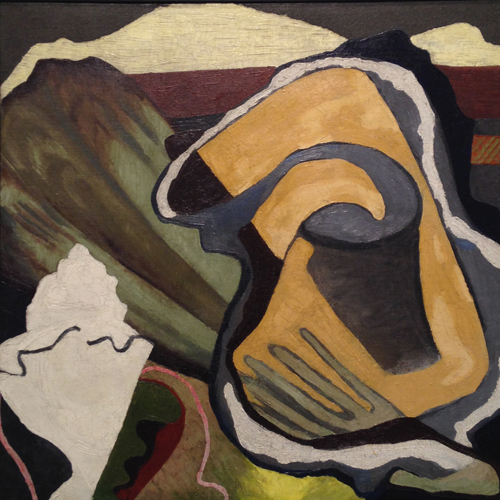 Untitled (Virgin Islands), 1934
Untitled (Virgin Islands), 1934
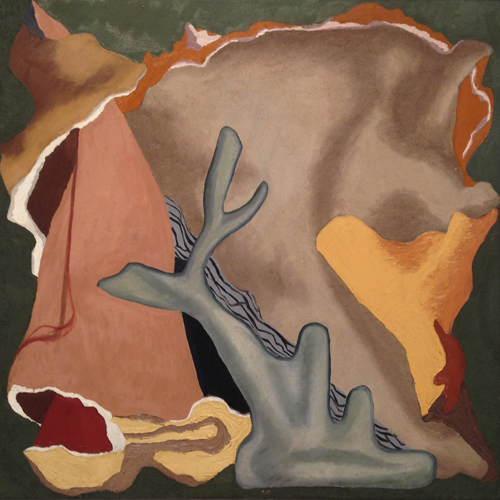 Untitled (Virgin Island Landscape Coral, 1930
Untitled (Virgin Island Landscape Coral, 1930
The Landscape
I have never looked at a landscape without seeing
other landscapes
I have never seen a landscape without visions
of things I desire and despise
lower landscapes have crusts of heat — raw epidermis
and the choke of vines
the separate lines of salt errors — the monadnocks
of fungus
the balance of stone — with gestures to grow
the lost posts of manmade boundaries — in moulten
shade a petrified paperhanger who shot the duck
a landscape is a still life of Chaldean history
it has faces I do not know
its mountains are always sobbing females
it is bags of melons and prickle pears
its woods are sawed to boards
its black hills bristle with maiden fern
its stones are Assyrian fragments
it flows the bogside beauty of the river Liffey
it is colored by Indiana gas green
it is steeped in veritable indian yellow
it is the place I’ve travelled to and never found
it is somehow veiled to vision by pious bastards
and the lord of Varu the nobleman from Gascogne
in the distance it seems threatened by the destruction
of gold
The position for vision has undergone changes
The canvas is a flat— a mile or two up —
earth surface depth doesn’t seem important — the importance
becomes pattern —
the importance of nature pattern in relation to man made pattern
from boundaries made by early work — relationship of work to area —
the roadways the drainage — the untillable —
How big a bite can a man take, can he manage more with machine —
change areas lines overlaid — yet from the upper view the old lines of
80 years ago still show- under soft snow the delicate lines of erosion —
the force of wind and solidifying action in use
the overlap — the dark openwater — the trapped snow, arrowheads —
the hairy figures of moraine
the crew cut woodlands
the once used form so soft and subtle
at a distance oil storage tanks and their moats
the 64 belly buttons for a hundred square miles
 Untitled (Head, Blue & White), 1934
Untitled (Head, Blue & White), 1934
The Cloud
The floating body with the
Chimeric head of
a bird and a star for a
belly button —
The legs float out into
the tails of a nightshirt
all the fold pieces are
individual entities
with their own attributes
unrelated to clouds but
related to pebbles
on a beach— gallstones in a
bladder — curd in a
sour mash — soft like
begonia petals gently
moving to be drawn to
sugared taffy
The eye moon floats out
of the night trap the
star moves to kneecap.
The bird head turns to pickerel
the nightshirt rolls and falls
The nude body of begonia
scales trails milky spawn
The moon has moved to
the eye of a snarling tiger
and I wonder how many
of my Chinese friends are killed tonight
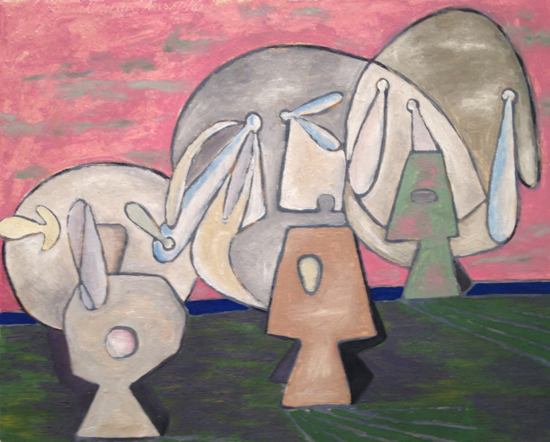 Untitled, 1946
Untitled, 1946
I feel no tradition. I feel great spaces.
I feel my own time. I am disconnected.
I belong to no mores – no party – no religion-
no school of thought – no institution.
I feel raw freedom and my own identity. I feel a
belligerence to museums, critics, art historians, aesthetes
and the so called cultural forces in a commercial order.
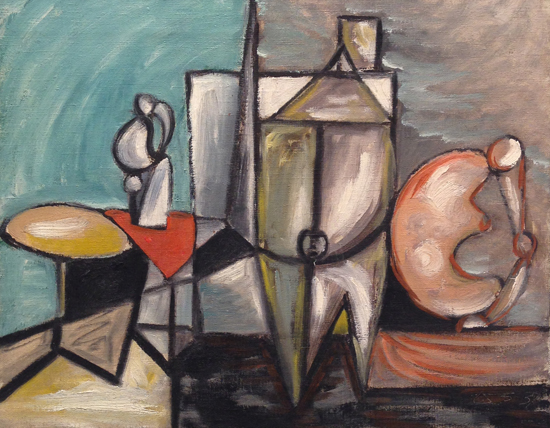 Untitled, 1937
Untitled, 1937
How little I know — until I see what happened in the night on
the snow — the movement of animals, their paths, and why — the animals
that fly the night birds leave no tracks except on the mind
the star tracks that angle to the earth sharp and direct
the broad brushing of the wind shown only the the snow plops
from branches — circulating the brushes and trees.
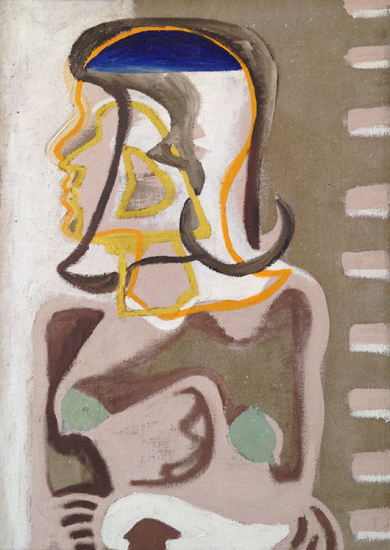 Untitled, 1930
Untitled, 1930
Dream
A dream is a dream never lost
I’ve had it inside a 4-8-4 on the top of a Diesel Engine,
they have been in a size dream.
I found an old flatcar
asked for, and was given it —Had I used the flatcar for the base
and made a sculpture on the top
the dream would have been closerI could have loaded a flatcar with
vertical sheets, inclined planes, uprights —
with holes, horizontals supported —I could have made a care with
the nude bodies of machines,
undressed of their details and teeth —I could have made a flatcar with
a hundred anvils of varying sizes and character
which I found at forged stations.I could have made a flatcar with
painted skeletal wooden patternsIn a year I could have made a trail
the flatcar I had is now melted
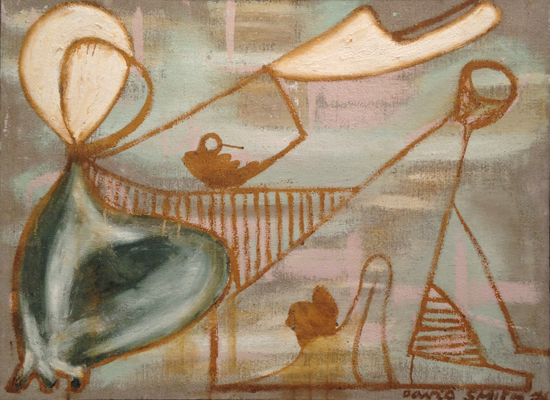 Untitled, 1934
Untitled, 1934
The Question – what are your influences
From the history of art and the myth of woman
from the half of a part chewed chicken rib cage
and out of a friend salted mackerel spine
the structure of August hatched moths that come off the mountains
the color of moths that blind in my arc
out of Beethoven’s E flat major, opus 31 and
the statement about intent he made at the time
from brush marks on a wall
the personages that grain pine boards
the great spots on paper
the creatures in foliage
the statements of nature — the underlying structure
which form the object, its whole or its parts-
related by associations not yet befouled by commerce
the nature of accident made by man as they fall in unity
as if directed by genes and generations
From Lahey’s thrust, from Sloan’s cones and cubes
from Matulka’s cubist concept and aggressive inquiry
from Graham’s erratic finesse from Davis’ conversations
over ale at McSorleys or Stewarts over coffee, his
caustic disdain for the stuffed shirts in our professional
world, his enthusiasm for pine top Smith
From all my friends and contemporaries
Directives too come from the way swallows dart
The way trees fall
the shape of rocks
the color of a dry doe in brown
the way bark grows on basswood sprouts
the head of a turtle — the vertebrae
the memory of the soup it made
and the 52 ping pong balls it never laid
the roll of the mountains after the day’s work
on the walk from the shop to my house
the way stars track
from bugs and butterflies under magnification
dividing to find the common denominators
the antennae, body movement to shape, the joints of the legs
and feet, squared by the memory of fish and the behavior of man
the ecstasy of a piano sonata and black coffee at midnight
the pieces finished outside the shop
the piece underway — the piece finished conceptually
the odds on the wall, the patterns in the rafters,
the stack of materials, the tools to form it and the work to come
the memory of 1 Atlantic Avenue, the odds on the wall,
the ship’s ventilators that hung from the rafters, the
rusty rows of forging tongs
the banks of hardies, the forging beds, the babbit ladies
the stacks of buffalo horn
the boxes of barrier reef pearl shells
the baskets of pistol handles in various stages of finish and polish
the rows of every revolver frame ever made, the clatter of
barge fuel pumps, the backwater roll of an incoming ferry
the crunch of Levy the barge oiler walking thru the cinder
yard out the gate for coffee
from the way booms sling
from the ropes and pegs of tent tabernacles
and side shows at country fairs in Ohio
from the bare footed memory of unit relationships on
locomotives sidling thru Indiana,
from hopping freights, from putting the engines together and
working on their parts in Schenectady
From everything that happens to circles
and from the cultured forms of woman and the free growth
of mountain flowers . . .
From no one, individually, but selection
from the cube root of all in varying
context.
David Smith: Origins & Innovations, Hauser & Wirth, images courtesy of Arteidolia
Writings from David Smith on David Smith, edited by Cleve Gray, Holt Rinehart Winston, 1968
